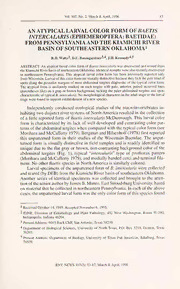
An Atypical Larval Color Form Of Baetis Intercalaris (Ephemeroptera: Baetidae) From Pennsylvania And The Kiamichi River Basin Of Southeastern Oklahoma PDF
Preview An Atypical Larval Color Form Of Baetis Intercalaris (Ephemeroptera: Baetidae) From Pennsylvania And The Kiamichi River Basin Of Southeastern Oklahoma
Vol. 107,No.2,March&April, 1996 83 AN ATYPICAL LARVAL COLOR FORM OF BAETIS INTERCALARIS (EPHEMEROPTERA: BAETIDAE) FROM PENNSYLVANIAAND THE KIAMICHI RIVER BASIN OF SOUTHEASTERN OKLAHOMA1 R.D.Waltz2,D.E.Baumgardner3-4,J.H.Kennedy4'5 ABSTRACT: An atypical larvalcolorformofBaetisintercalariswasdiscoveredandreared from theKiamichiRiverbasinofsoutheasternOklahoma.Identicalnymphswerealsorecentlydiscovered in northeastern Pennsylvania. This atypical larval color form has been previously reported only fromWisconsin.Larvaeofthiscolorformarevisuallydistinctivebecausetheylackthepaletriadof spotsalongthe posteriormarginsofmostabdominal tergitesdiagnostic ofthetypical colorform. The atypical form is uniformly marked on each tergite with pale, anterior, paired incurved lines (parentheses like) on agrayorbrown background, lacking the palerabdominal tergites and spots characteristicoftypicalB. intercalaris.Nomorphologicalcharactersintheadultstageorthelarval stagewerefoundtosupportestablishmentofanewspecies. Independently conducted ecological studies of the macroinvertebrates in- habiting two disjunct riversystems ofNorthAmerica resulted in the collection ofa little reported form ofBaetis intercalaris McDunnough. This larval color form is characterized by its lack of well developed and contrasting color pat- ternsofthe abdominal tergites when compared with the typical color form (see Moriharaand McCafferty 1979). Bergman and Hilsenhoff(1978) firstreported this unpatterned form in their studies of the Wisconsin Baetidae. The unpat- terned form is visually distinctive in field samples and is readily identified as unique due to the flat gray or brown, non-contrasting background color of the abdominal tergites (Fig. 1), typical "intercalaris" type of prothorax pattern (Moriharaand McCafferty 1979), and medially banded cerci and terminal fila- ment. No otherBaetis species in NorthAmerica is similarly colored. Larval specimens ofthe unpatterned form ofB. intercalaris were collected andreared (by DEB) from the Kiamichi Riverbasin ofsoutheastern Oklahoma. Another series of identical specimens was collected and brought to the atten- tionoftheseniorauthorbyJamesB. Munro,EastStroudsburgUniversity,based on material that hecollected in northeastern Pennsylvania. In each ofthe above cases, the unpatterned larval form was theonly color form ofthis species found 1 ReceivedOctober 14, 1995.AcceptedNovember6, 1995. 2 IDNR, Division of Entomology and Plant Pathology, 402 West Washington, Room W-290, Indianapolis, Indiana46204. 3 PresentAddress:9015RockCliff,SanAntonio,Texas78230. 4Department ofBiological Sciences, University ofNorth Texas, P.O. Box 5218, Denton, Texas 76203. 5 Present Address: Department of Biology, University ofTexas Pan American, Edinburg, Texas 78539. ENT. NEWS 107(2): 83-87,March&April. 1996 84 ENTOMOLOGICALNEWS atthesite.TypicalcolorformsofB. intercalariswerenotpresentinsiteswhere collections were made ofthe unpatterned form. MATERIAL EXAMINED Material which formed the basis for this report includes the following lar- val, adult, and reared adult specimens: OKLAHOMA: Pushmataha Co., Kiamichi R. at Hwy 2, 16.3. mi N Hwy 2-3 jet, D.E. Baumgardner, 16-IX-1993, 2L, and 14-X-1993, 2 reared male adults, 1 reared female adult, 7L. OK: LeFloreCo., Kiamichi R.atHwy259,approx.0.5miSHwy63-259jeWt, 18-VII-1993,D.E. Baumgardner,2L.OK:LeFloreCo.,PigeonCrkatHwy63,approx.5.5mi Oklahoma-Arkan- sasborder, 19-VI- 1993, D.E. Baumgardner, 1 maleadult. OK: PushmatahaCo., Dry Crkatun- named lowwatercrossing,approx.2.5miETuskahoma, 17-VII-1993,D.E. Baumgardner, 1L. PENNSYLVANIA: PikeCounty, BloomingGroveCreek,6,27-VII 1993; 10,24-VIII-1993; 9-IX-1993,and4-X-1993,JamesB. Munro. Representative vouchers havebeen deposited in thePurdueEntomological Research Collection, West Lafayette, Indiana, and University ofNorth Texas, Denton, Texas. IDENTIFICATION Larvae of the unpatterned form will reach an impasse in the key couplet separating Baetis intercalaris from B. flavistriga McDunnough in Morihara andMcCafferty(1979:couplet 19)becausethetergalpalespotsarenotpresent. To accommodate identification ofthe unpatterned form, couplet 19 ofthe key may be modified to read: 19. Darker,well-markedabdominaltergiteswithtwolargesubmedianpaleareas,oftenkidney shaped B.flavistriga 19'. Darker, well-marked abdominal tergites with 3 posteriorround pale areas, middle spot often smaller than laterals or abdominal tergites uniformly gray or brown with pale parentheses-likemarksatmiddle,anteriormarginofeachtergite B. intercalaris Confirmation oftentativelarval identifications using this modifiedcouplet shouldcontinuetobeaccomplished by usingtheexpandeddiagnosis underthe species discussion ofB. intercalaris in Morihara and McCafferty (1979). In some specimens, the slide mounted larval exuviae of the unpatterned form showed indication ofpale tergal areas on the anterior tergites when examined with indirect substage lighting. The adult ofthe reared, atypical larva keys readily toB. intercalarisin the most recent keys to theBaetis species adults (Traver 1935) based on the elon- gated marginal intercalaries of the first interspace in the forewing. However, adults ofthe reared atypical specimens possessed adark-brown thorax, rather Vol. 107,No.2,March&April, 1996 85 Figure 1.Baetisintercalaris(unpatternedform). Dorsalhabitus(photograph). 86 ENTOMOLOGICALNEWS than the black thorax of typical B. intercalaris. Such color differences in the adult stage have been regarded as within the observed limits of intraspecific variation in closely allied species, e.g., B. flavistriga (see Morihara and McCafferty 1979 and Traver 1935) and in Baetis dubius (Walsh) (Waltz, per- sonal observation). Furthercomparisons ofthe adult male reared from the un- patternedlarvalformwithadultmalesrearedfromtypicalB. intercalarislarvae showed nodiscerniblemorphological differences. BIOLOGYAND DISCUSSION Baetis intercalaris, widely distributed in the Kiamichi Riverdrainage, was collectedfromthirdthroughfifthorderstreamsin theupper,middle, andlower reaches ofthedrainage. Larvae were collectedfrom gravel/pebble substrate in riffles. Other studies have reported similar habitats for this species (Bergman and Hilsenhoff 1978; Bernerand Pescador 1988). BaetisintercalarismayhavetwogenerationsperyearintheKiamichiRiver drainage, consisting of a spring and a fall generation. Immature larvae were first collected in June 1993, with late instar and emerging larvae collected in October, indicating the fall generation.Although no larvae were collected be- foreJune, asingle adult wascollected inJune 1993, suggesting theoccurrence ofa spring generation. In the northern regions ofits range, B. intercalaris has been reported variously as univoltine (Bergman and Hilsenhoff 1978; Harper and Harper 1984), or bivoltine (McDunnough 1921, 1923; Ide 1935). Emer- genceofB. intercalarisoccursthroughouttheyearinthesouthernregionsofits range (Berner and Pescador 1988), and often has no cohort synchronization (Jacobi and Benke 1991). Thecauseoftheatypicalcolorvariation isunclearatthistime.Theatypical colorformcouldrepresentacrypticspecies.Asecond,andmoreprobablecause, is that this atypical color form may be a result ofsome, as yet not identified, environmental factor causing the differences in color. Not only are there no obvious morphological differencesin thetypical versus theatypical forms, but thepresenceofpatterningcommon tothetypical form, thatis vaguelydiscern- ibleinatleastsomelarvaeoftheatypical form,leadsustoseekanenvironmen- talcausefortheatypicalcoloration.Alloftheunpatternedformlarvaereported hereinwerecollectedinthemidtolatesummer,orthesecondgenerationcycle. Noearlier, orspringgeneration, collectionsofthe unpatterned formare known to us. Additional studies, including rearings ofboth typical and atypical color formsfrom throughouttherangeofthisspecies,andlifehistory studies, willbe required to better understand the source ofthis atypical coloration. ACKNOWLEDGMENTS We thank James B. Munro and Bruce Haase, East Stroudsburg University, PA, for making theirmaterialofBaetisintercalaris(unpatternedform)availableforstudy. Vol. 107,No.2,March&April, 1996 87 LITERATURECITED Bergman,E.A.andW.L.Hilsenhoff. 1978. Baetis(Ephemeroptera: Baetidae)ofWisconsin.Gr. LakesEntomol. 11: 125-135. Berner,L.andM.L.Pescador. 1988.TheMayfliesofFlorida,RevisedEdition.UniversityPresses ofFlorida.415pp. Harper,P.P.and F.Harper. 1984. Phenologyand distributionofmayflies in asouthernOntario lowlandstream,pp.243-251.In:.V.Landa,elal.(eds.),Proc.FourthIntntl.Conf.Ephemeroptera. Czechoslovakia. Ide,F.P. 1935.Theeffectoftemperatureonthedistributionofthemayflyfaunaofastream.Univ. TorontoStud.,Biol Ser. 39,Pub.OntarioFishRes.Lab.50:9-76. Jacobi,D.I.andA.C.Benke.1991.Lifehistoriesandabundancepatternsofsnag-dwellingmayflies inablackwaterCoastalPlainRiver.J. N.Am. Benth. Soc. 10: 372-387. McDunnough,J. 1921.TwonewCanadianMayflies(Ephemeridae).Can.Entomol.53: 117- 120. McDunnough,J. 1923.NewCanadianEphemeridaewithnotes.Can.Entomol. 55: 39-50. Morihara,O.K.andW.P.McCafferty.1979.TheBaetislarvaeofNorthAmerica(Ephemeroptera: Baetidae).Trans.Am.Entomol.Soc. 105: 139-221. Traver,J.R. 1935.PartII,Systematic,pp.239-739.In:.J.G.Needham,J.R.Traver,Y.C.Hsu(eds.), ThebiologyofmayflieswithasystematicaccountofNorthAmericanspecies.ComstockPubl. Co., Ithaca,NY.
